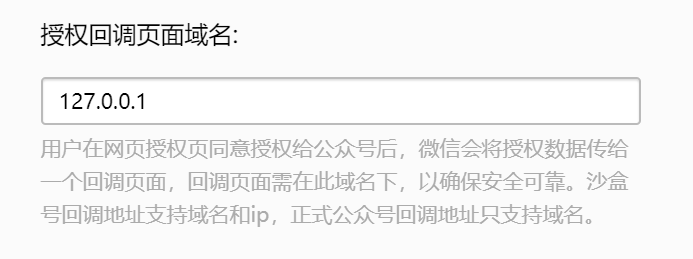一,登陆微信公众测试平台
https://mp.weixin.qq.com/debug/cgi-bin/sandbox?t=sandbox/login
a.拿到测试账号信息

b.扫描关注测试账号

c.设置回调地址,需要有服务器资源才可以接收到消息

二,创建Django项目进行测试

from django.conf.urls import url from django.contrib import admin from api import views urlpatterns = [ url(r'^admin/', admin.site.urls), url(r'^login/$', views.login), url(r'^bind/$', views.bind), url(r'^bind_qcode/$', views.bind_qcode), url(r'^callback/$', views.callback), url(r'^sendmsg/$', views.sendmsg), ]

import json import functools import requests from django.conf import settings from django.shortcuts import render, redirect, HttpResponse from django.http import JsonResponse from api import models # 沙箱环境地质:https://mp.weixin.qq.com/debug/cgi-bin/sandbox?t=sandbox/login def index(request): obj = models.UserInfo.objects.get(id=1) return render(request, 'index.html', {'obj': obj}) def auth(func): @functools.wraps(func) def inner(request, *args, **kwargs): user_info = request.session.get('user_info') if not user_info: return redirect('/login/') return func(request, *args, **kwargs) return inner def login(request): """ 用户登录 :param request: :return: """ # models.UserInfo.objects.create(username='luffy',password=123) if request.method == "POST": user = request.POST.get('user') pwd = request.POST.get('pwd') obj = models.UserInfo.objects.filter(username=user, password=pwd).first() if obj: request.session['user_info'] = {'id': obj.id, 'name': obj.username, 'uid': obj.uid} return redirect('/bind/') else: return render(request, 'login.html') @auth def bind(request): """ 用户登录后,关注公众号,并绑定个人微信(用于以后消息推送) :param request: :return: """ return render(request, 'bind.html') @auth def bind_qcode(request): """ 生成二维码 :param request: :return: """ ret = {'code': 1000} try: access_url = "https://open.weixin.qq.com/connect/oauth2/authorize?appid={appid}&redirect_uri={redirect_uri}&response_type=code&scope=snsapi_userinfo&state={state}#wechat_redirect" access_url = access_url.format( appid=settings.WECHAT_CONFIG["app_id"], # 'wx8c2fa5dcf5d92873', redirect_uri=settings.WECHAT_CONFIG["redirect_uri"], # 'http://127.0.0.1/callback/', state=request.session['user_info']['uid'] # 为当前用户生成MD5值 ) ret['data'] = access_url except Exception as e: ret['code'] = 1001 ret['msg'] = str(e) return JsonResponse(ret) def callback(request): """ 用户在手机微信上扫码后,微信自动调用该方法。 用于获取扫码用户的唯一ID,以后用于给他推送消息。 :param request: :return: """ code = request.GET.get("code") # 用户md5值 state = request.GET.get("state") # 获取该用户openId(用户唯一,用于给用户发送消息) res = requests.get( url="https://api.weixin.qq.com/sns/oauth2/access_token", params={ "appid": 'wx89085e915d351cae', "secret": '64f87abfc664f1d4f11d0ac98b24c42d', "code": code, "grant_type": 'authorization_code', } ).json() # 获取的到openid表示用户授权成功 openid = res.get("openid") if openid: models.UserInfo.objects.filter(uid=state).update(wx_id=openid) response = "<h1>授权成功 %s </h1>" % openid else: response = "<h1>用户扫码之后,手机上的提示</h1>" return HttpResponse(response) def sendmsg(request): def get_access_token(): """ 获取微信全局接口的凭证(默认有效期俩个小时) 如果不每天请求次数过多, 通过设置缓存即可 """ result = requests.get( url="https://api.weixin.qq.com/cgi-bin/token", params={ "grant_type": "client_credential", "appid": settings.WECHAT_CONFIG['app_id'], "secret": settings.WECHAT_CONFIG['appsecret'], } ).json() if result.get("access_token"): access_token = result.get('access_token') else: access_token = None return access_token access_token = get_access_token() openid = models.UserInfo.objects.get(id=1).wx_id def send_custom_msg(): """发送普通消息""" body = { "touser": openid, "msgtype": "text", "text": { "content": 'hello' } } response = requests.post( url="https://api.weixin.qq.com/cgi-bin/message/custom/send", params={ 'access_token': access_token }, data=bytes(json.dumps(body, ensure_ascii=False), encoding='utf-8') ) # 这里可根据回执code进行判定是否发送成功(也可以根据code根据错误信息) result = response.json() return result def send_template_msg(): """ 发送模版消息 """ res = requests.post( url="https://api.weixin.qq.com/cgi-bin/message/template/send", params={ 'access_token': access_token }, json={ "touser": openid, "template_id": 'sQHb_6WoMbFSleTEKYhBl1_RQ5w2iq1bz53vFRf_rjk', # 模版id "data": { "first": { "value": "hello", "color": "#173177" }, "keyword1": { "value": "美女", "color": "#173177" }, } } ) result = res.json() return result result = send_template_msg() # 模板消息 # result = send_custom_msg() # 普通消息 if result.get('errcode') == 0: return HttpResponse('发送成功') return HttpResponse('发送失败')

import hashlib from django.db import models class UserInfo(models.Model): username = models.CharField("用户名", max_length=64, unique=True) password = models.CharField("密码", max_length=64) uid = models.CharField(verbose_name='个人唯一ID', max_length=64, unique=True) wx_id = models.CharField(verbose_name="微信ID", max_length=128, blank=True, null=True, db_index=True) def save(self, *args, **kwargs): # 创建用户时,为用户自动生成个人唯一ID if not self.pk: m = hashlib.md5() m.update(self.username.encode(encoding="utf-8")) self.uid = m.hexdigest() super(UserInfo, self).save(*args, **kwargs)

# ############# 微信 ############## WECHAT_CONFIG = { 'app_id': 'wx8c2fa5dcf5d92873', 'appsecret': 'bd122291fa7bb9411ddb1290aa296821', 'redirect_uri': 'http://127.0.0.1/callback/', }
templates文件

<!DOCTYPE html> <html lang="zh-CN"> <head> <meta charset="UTF-8"> <title>Title</title> <meta name="viewport" content="width=device-width, initial-scale=1"> </head> <body> <h1>{{ obj.username }} -> {{ obj.wx_id }}</h1> </body> </html>

<!DOCTYPE html> <html lang="en"> <head> <meta charset="UTF-8"> <title>Title</title> </head> <body> <form action="/login/" method="post"> {% csrf_token %} <input type="text" name="user" placeholder="用户名"> <input type="password" name="pwd" placeholder="密码"> <input type="submit" value="登录"> </form> </body> </html>

{% load staticfiles %} <!DOCTYPE html> <html lang="en"> <head> <meta charset="UTF-8"> <title>Title</title> </head> <body> <div style=" 600px;margin: 0 auto"> <h1>并绑定个人用户(用于以后的消息提醒)</h1> <div> <h3>第一步:微信服务测试号</h3> <img style="height: 100px; 100px" src="{% static "img/wechat.jpg" %}"> </div> <input type="button" value="下一步【获取绑定二维码】" onclick="getBindUserQcode()"> <div> <h3>第二步:绑定个人账户</h3> <div id="qrcode" style=" 250px;height: 250px;background-color: white;margin: 100px auto;"></div> </div> </div> <script src="{% static "js/jquery.min.js" %}"></script> <script src="{% static "js/jquery.qrcode.min.js" %}"></script> <script src="{% static "js/qrcode.js" %}"></script> <script> function getBindUserQcode() { $.ajax({ url: '/bind_qcode/', type: 'GET', success: function (result) { console.log(result); $('#qrcode').empty().qrcode({text: result.data}); } }); } </script> </body> </html>
三,发送模板消息
a.在测试平台添加模板信息

b.配置模板消息
def send_template_msg(): """ 发送模版消息 """ res = requests.post( url="https://api.weixin.qq.com/cgi-bin/message/template/send", params={ 'access_token': access_token }, json={ "touser": openid, "template_id": 'sQHb_6WoMbFSleTEKYhBl1_RQ5w2iq1bz53vFRf_rjk', # 模版id "data": { "first": { "value": "hello", "color": "#173177" }, "keyword1": { "value": "美女", "color": "#173177" }, } } ) result = res.json() return result result = send_template_msg() # 模板消息
